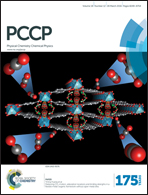Molecular interactions between ammonium-based ionic liquids and molecular solvents: current progress and challenges†
Abstract
In view of the spacious scope of structural information and the molecular interactions between ammonium-based ionic liquids (ILs) and molecular solvents in various applications including chemical and pharmaceutical that are crucial for all aspects of scientific community, the knowledge of the molecular mechanisms, in particular, the thermodynamic basis of the structure-breaking/making interactions as well as the packing effect of the molecular liquids is essential to understand the ion–ion and ion–solvent interactions that exist in the liquid mixtures. In this perspective, we describe how the thermodynamic parameters can be effectively used to gain valuable insights into molecular interactions between ammonium-based ILs and molecular solvents, which would be most useful in various industries. This perspective presents the thermophysical properties of pure ammonium-based ILs, then these properties of the mixtures of these ILs with other solvents, and reviews the correlation researches on the properties of these systems. Finally, this perspective also brings a brief overview on several studies accomplished in this area by various researchers.

- This article is part of the themed collection: PCCP Perspectives

 Please wait while we load your content...
Please wait while we load your content...